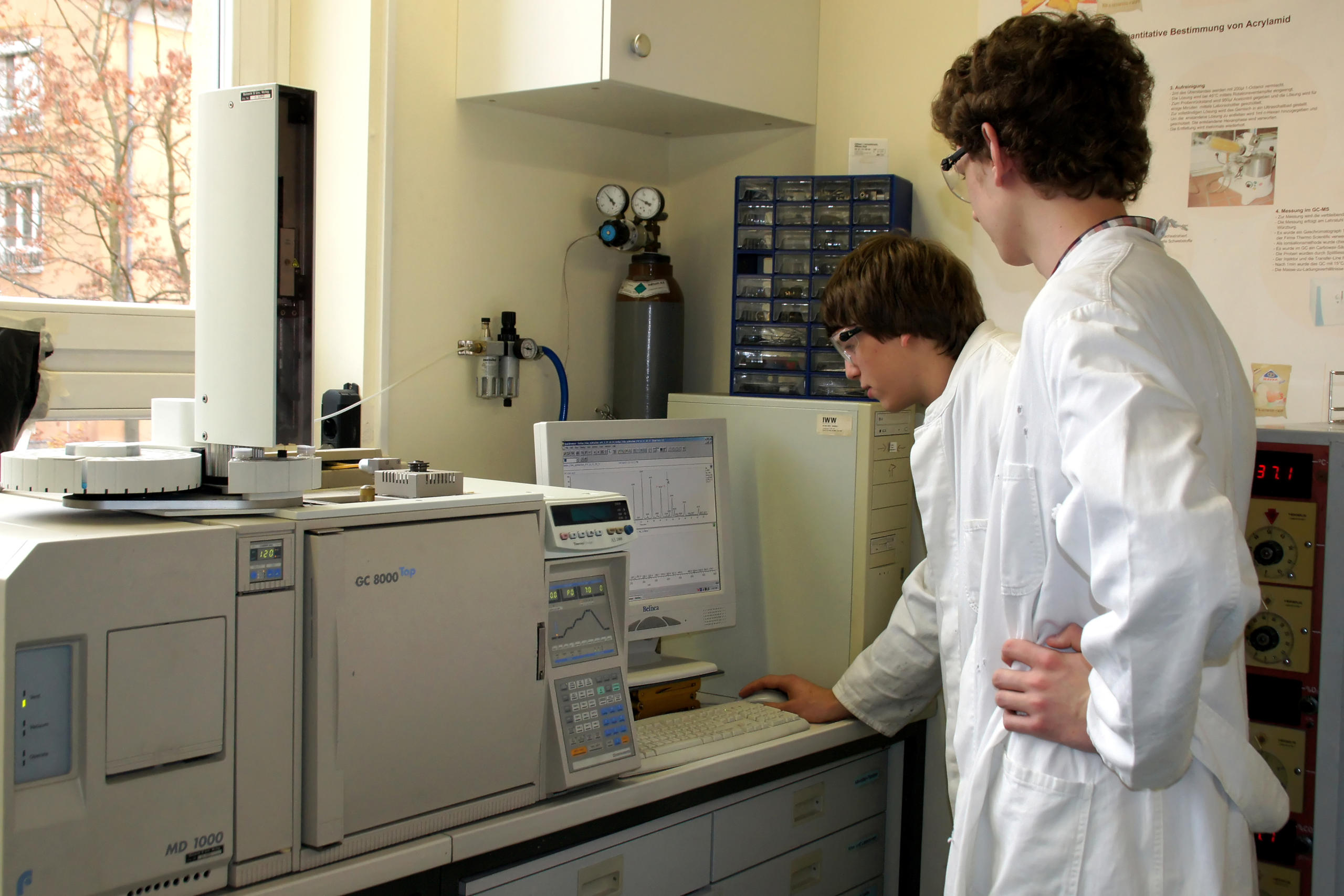
Polar lights over the Hans Haffner Observatory
On the night of Friday, May 10, 2024 to Saturday, May 11, 2024, spectacular auroras could be observed at the Hans Haffner Observatory.
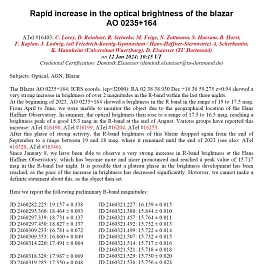
Once again an Astronomer's Telegram published
"ATel #16403: Rapid increase in the optical brightness of the blazar AO 0235+164" This Astronomer's Telegram is now the 22nd ATel published by the Hans Haffner Observatory student team.
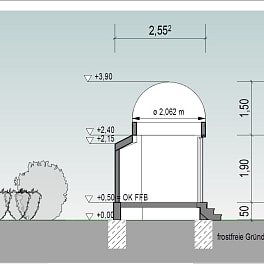
Building application for the expansion of the observatory has been approved
The Hans Haffner Observatory is to be expanded next year to include a small domed building and a larger area of around 300 square metres. The Würzburg District Office has now approved the building application for the domed building, meaning that work can begin in spring 2024.

Natural science library completely renovated
After more than 2 years, the renovation of the Natural Sciences Library is now complete. Firstly, the actual room of the library, room H17a, was completely renovated.
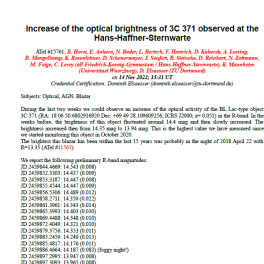
13th Astronomers Telegram: strong increase in brightness of AGN 3C 371
Since the beginning of November, the brightness of AGN 3C 371 has been steadily increasing slightly. On Sunday evening, 12.11.2022, we were able to measure a stronger increase in the optical brightness of this object.

Award for astronomy project of the FKG student science laboratory
The astronomy group of the Science Laboratory of the Friedrich-Koenig-Gymnasium was awarded a Reiff Prize for school and amateur astronomy in Bochum at the weekend.
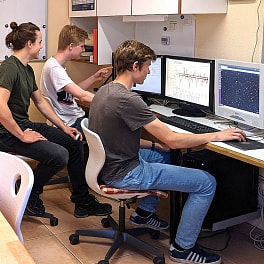
Data from Hettstadt helped to get closer to the puzzle of kink instabilities in jets
In the naturally occurring plasma streams of the jets of active galactic nuclei magnetohydrodynamic instabilities are suspected, however the exact connections with suddenly occurring brightness bursts of AGN, so-called flares, have not yet been fully unraveled. In the current issue of the highly renowned journal Nature, an article has now been published in which an important step in this direction is taken.
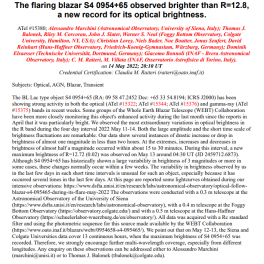
AGN S4 0954 reached an absolute brightness maximum
In the night from 11 to 12 May we were able to measure a strong increase in the optical brightness of AGN S4 0954. We have only had this AGN in our measurement programme for almost two years. Shortly after the detection, Tom Balonek from Colgate University in New York sent us a hint about this increase in brightness via the e-mail distribution list of the Whole Earth Blazar Telescope (WEBT) Collaboration. Italian scientists were also able to measure this burst of brightness. In the following nights, S4 0954 was still closely monitored by the scientists from New York, Siena and Milan as well as by us. On 14 May, in a joint effort, an Astronomers Telegram on this event was published as a joint achievement. S4 0954 belongs to the subgroup of BL Lacertae objects, a group of active galactic nuclei that are very bright. Scientists assume that in these objects the accretion disk is more or less perpendicular to our line of sight, so that we look almost directly into the jet. This also explains the relatively high brightness of these celestial objects.
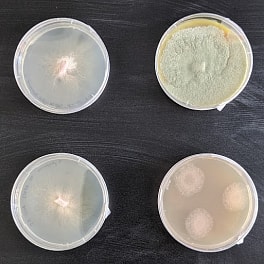
Two new fungal cultures established in our laboratory
Two more sterile cultures of fungi have been established in the student laboratory. Firstly, cultures of the ergot fungus Claviceps purpurea and secondly of Trichoderma reesei. The ergot fungus, which belongs to the group of Ascomycota, parasitises on grain ears, especially on those of rye. The bluish-black ergot, up to four centimetres long, is a permanent stage (sclerotium) with which the fungus survives the winter. This contains a mixture of several dozen alkaloids, some of which are highly toxic. In the Middle Ages and early modern times, the consumption of ergot-infested grain caused the so-called Saint Anthony's fire. A person suffering from what is now called ergotism was depicted by Matthias Grünewald on the second reverse side of the Isenheim Altarpiece. Later, extracts of Sclerotia from Claviceps were used to staunch bleeding after a difficult birth due to their vaso-occlusive effect. The lines that have now been established are to be analysed for their alkaloid composition as well as for the dyes they contain. They were made available to us by the working group of Prof. Dr. Humpf from the University of Münster. Trichoderma reesei belongs to the tubular fungi. It is characterised by a high production of cellulases, i.e. enzymes that break down cellulose, the scaffolding substance of plant cell walls. The aim here is to isolate these cellulases and then use them for further experiments. The culture of Trichoderma was made available to us by the working group of Prof. Dr. Agler-Rosenbaum from the Leibniz Institute for Natural Product Research and Infection Biology in Jena.
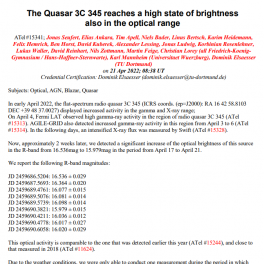
Brightness outburst of AGN 3C 345 detected
In early April, AGN 3C 345 showed increased activity in the gamma range of the electromagnetic spectrum. This was detected by both the Fermi LAT, the Large Area Telescope on the Fermi satellite, and the AGILE satellite. The Swift research satellite was then able to measure an additional increase in X-rays from this object in the following days. AGN 3C 345, a quasar, has been part of our schedule at the Hans-Haffner-Observatory for several years. For this reason, we were especially attentive over the next few nights and were actually able to measure an increase in the brightness of this AGN by over one magnitude in the period from 17 to 20 April, the first in the world to do so, and to publish our now tenth Astronomers Telegram.
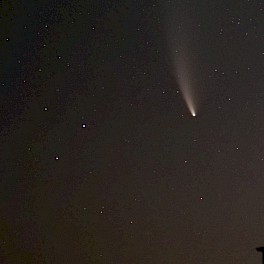
Comet C/2020 F3 (Neowise) above the Hans Haffner Observatory
For a comet of this size - the diameter is estimated by NASA to be about 5000 meters - this celestial object was discovered unusually late, only in spring this year. On March 27th, 2020, NASA's Wide-Field Infrared Survey Explorer (WISE) detected the comet as part of the NEOWISE project, which scans the southern sky. Already on July 3rd, comet C/2020 F3, as it has been correctly named since then, reached its perihelion, the point closest to the sun on its elliptical orbit. Comets consist mainly of ice, which is made of water, carbon monoxide and carbon dioxide, and dust - which is why astronomers call them dirty snowballs. When such an ice ball approaches the sun, the volatile part of the matter begins to evaporate and forms the coma (shell) around the comet's core. By the solar wind a part of the coma is pushed away, which can be seen as a tail. From the beginning of July, NEOWISE, as its colloquial name is known, could be observed very well in the morning sky above the Hans Haffner Observatory. As it now moved away from the sun again, it became darker with each passing day. At the same time, visibility shifted further forward during the course of the day, so that from mid-July onwards it could also be seen in the evening sky. On 23rd July it had reached the smallest distance to the earth with 103.5 million km. In the following nights the brightness of this tail star decreased more and more and since the beginning of August it is no longer visible with the naked eye. If it survives its journey through space undamaged, C/2020 F3 will not pass earth again for another 6700 years.
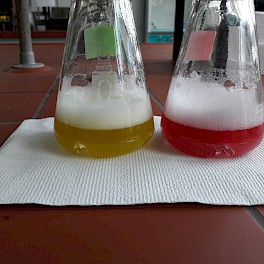
New cell disruption process established
Bacteria can be genetically modified to produce specific proteins. In the pharmaceutical industry, for example, human insulin is produced in this way. In the student laboratory, transgenic Escherichia coli bacteria are used to synthesize fluorescent proteins. Originally, the gene for the green fluorescent protein (GFP) comes from the jellyfish Aequorea victoria. This protein can be excited to green fluorescence with ultraviolet light. The GFP was first described in 1962 by the Japanese biochemist Osamu Shimomura. In modern research, GFP and the variants emanating from it are an important tool for studying the spatial and temporal distribution of proteins in a cell. For this purpose, the GFP gene is coupled with the protein gene under investigation. If this gene is now expressed, the GFP is also synthesized. By irradiation with UV light, the GFP starts to glow and thus the time and place of occurrence of the protein under investigation can be determined. In the meantime, there are numerous proteins that fluoresce in all colors. In the student laboratory we produce bacteria that produce either a green (GFP) or a red (RFP) fluorescent protein. After the transgenic bacteria were incubated overnight, they produced the protein. This protein is then extracted from the bacteria by "cracking" the bacteria. In the absence of other alternatives, cell disruption in the school lab has so far been done by enzymatic digestion with lysozyme. This procedure was very lengthy and not very successful. Now, an ultrasound disintegrator for mechanical cell disruption with ultrasound could be purchased and the new procedure implemented in the student laboratory. The ultrasound disintegrator transmits high-energy ultrasound waves into the bacterial suspension with a sonotrode tip. The resulting cavitation forces (cavitation: formation and dissolution of gas bubbles) cause the bacterial cells to collide violently with each other and thus break up. This releases the cell contents including the proteins. The proteins can now be purified accordingly and obtained in pure form. This process was established by the former FKG students Jannik Kania and Julius Klamt, who study chemistry and biology at the University of Würzburg.
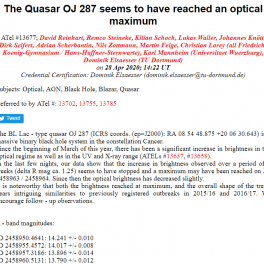
Brightness maximum of AGN OJ 287 discovered
The brightness of the blazar OJ 287 has been regularly determined by us since the beginning of the research project "AGN-Monitoring". From the end of March 2020 we could observe an increase in brightness of this object, which peaked on April 26th of 2020. During these almost six weeks the brightness of this Active Galaxy Nucleus (AGN) increased by 1.25 magnitudes and decreased again afterwards. This discovery was published in an ad-hoc announcement in Astronomer's Telegram worldwide. The Astronomer's Telegram is an Internet platform where significant astronomical events are quickly spread around the world so that they are documented and can be verified all over the globe. The students' measurements and evaluations matched very well with the observations of other working groups. The monitoring of AGN at the Hans Haffner Observatory is carried out in coordination with the MAGIC collaboration, which operates a telescope system for gamma radiation on the Canary Island of La Palma. Unfortunately, parallel measurements could not be performed there due to the corona shut-down. OJ 287 is located in the constellation of Cancer, is 3.5 billion light years away from earth and contains one of the largest known black holes, with 18 billion solar masses. This supermassive black hole is orbited by a smaller second black hole, which weighs about 100 million solar masses and takes about 12 years to orbit. During this orbit, it passes twice through the accretion disk of the central black hole, which leads to strong disturbances of the jet emanating from it. This is also reflected in brightness fluctuations observed from earth. Due to the brightness outbursts it was possible to determine the masses of this binary system of black holes very precisely. The orbit of the small black hole could also be determined very precisely. It was also found that the two black holes converge and merge in 10 000 years. Therefore, OJ 287 is also an interesting object for measuring gravitational waves with the planned space interferometer LISA. The project "AGN-Monitoring" in cooperation with the Chair of Astronomy of the University of Würzburg and the Chair of Experimental Particle Physics 5b of the Technical University Dortmund exists since 2012.

